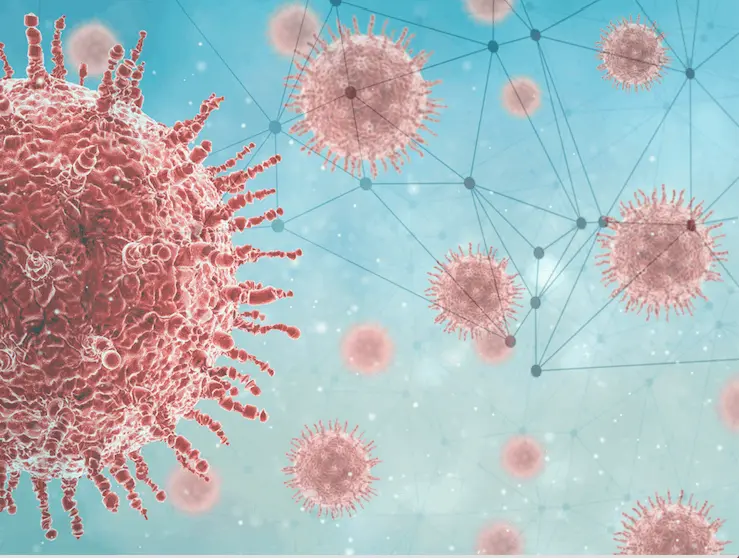A recent publication in Nature’s Communications Medicine has presented the TNBC (Triple Negative Breast Cancer) ICI (Immune Checkpoint Inhibitors) response predictive classifier (TNBC-ICI) integrating gene expression profiles of TNBC specimens and artificial intelligence, which has demonstrated a significant performance in identifying TNBC patients who would potentially achieve pCR (Pathological Complete Response) to the chemotherapy treatment supplemented with ICI, opening an avenue to improve the decision making and disease management of patients diagnosed with primary TNBC.
Overview of the TNBC-ICI
Researchers from the Health Research Institute of the Balearic Islands (IdISBa), Spain, have implemented a random forest machine learning algorithm to construct and evaluate gene expression-based signatures to efficiently predict Pathological Complete Response (pCR) to Immune Checkpoint Inhibitors (ICI) therapy assisted with chemotherapy in patients with primary TNBC treated in the phase II/III I-SPY2 clinical trial that includes clinical and gene expression data. This study involved 188 ICI-naïve and 721 specimens treated with ICI plus chemotherapy.
Here, patients who achieved a pCR or absence of invasive cancer in the breast and regional nodes at the time of surgery were classified as ‘responders,’ whereas those who had residual disease were considered ‘non-responders’ during the classifier construction. The algorithm is applied to select the most informative gene combinations to predict response to ICI in primary TNBC tumors.
The classifier generates a confidence score for assessing the probability of response to ICI in patients with triple-negative breast cancer using a quantifiable measure instead of a dichotomic value of response/no response. The classifier includes 37 genes for which optimal performance of the signatures was established. Genes are mostly involved in pathways related to immune response, cytoskeleton, cell adhesion, metabolism, and transcription regulation.
Triple Negative Breast Cancer (TNBC) Associated Complexities and Treatment
Tumors associated with Breast cancer without expression of ER (estrogen receptor), PR (progesterone receptor), and overexpression of HER2 (human epidermal growth factor receptor 2); are defined as triple-negative breast cancer. Breast Cancer is mainly classified and treated based on ER, PR, and HER2 expression status.
The presence of these markers has allowed the development of targeted and efficient therapies for breast cancers, but in the case of TNBC, its aggressive nature meets the deficiency in defined biomarkers for targeted therapies, leading to clinical complexities.
Chemotherapy has remained the systemic therapeutic alternative for treating TNBC due to this condition for decades. TNBC is characterized by a relatively high Tumor Mutational Burden, which is connected with the comparatively successful responsiveness towards immunotherapy with immune-checkpoint inhibitors (ICIs).
Immunotherapy and Immune Checkpoint Inhibitors
Immune checkpoints keep a balance between pro-inflammatory and anti-inflammatory signals under homeostatic conditions. Pro-inflammatory signals trigger the immune system towards inflammation, and anti-inflammatory signals work antagonistically to maintain homeostasis. These immunological checkpoints are a group of inhibitory and stimulatory pathways that influence immune cell activity.
Therefore, Immune checkpoints prevent the destruction of healthy cells and the development of autoimmunity. A similar event is strategized by the cancer cells. Cancer cells can escape immunosurveillance by switching off T cells’ immune checkpoints, rendering tumor-induced immune suppression, and masking themselves from immune recognition and elimination.
In Immunotherapy, drugs called Immune Checkpoint Inhibitors block the checkpoints from binding with their ligand, prevent negative immune regulation, and allow the antitumor immune response. These drugs mostly target immune inhibitory receptors, such as CTLA-4, PD-1, and PD-L.
TNBC and ICI: Relevance of the Study
The authors mention the trial that outlined the combinatorial application of nab-paclitaxel with atezolizumab, which is a humanized antibody showing restoration of the antitumoral immune response through blocking PD-L1 expressed by tumoral cells, which increases the progression free survival (PFS) of patients with unresectable locally advanced or metastatic TNBC especially patients with positive PD-L1 tumors. Pembrolizumab, a humanized anti-PD-1 antibody, also displayed improvement in PFS and overall survival (OS) in patients with PD-L1-positive.
Nevertheless, a significant number of patients still do not achieve a pCR in response to ICI under the primary TNBC setting, highlighting the need for precision biomarkers that can be identified in primary TNBC patients who will benefit from the addition of ICI to chemotherapy. Identifying TNBC-specific markers to predict response to ICI will be helpful in diminishing unnecessary side effects and treatment expenses.
Researchers have deduced a gene expression signature to predict immunotherapy response in TNBC patients. TNBC patients with a predictive score generated through the classifier in the upper tertile are 21.3 more likely to achieve a pCR to ICI plus chemotherapy than those with lower TNBC-ICI scores (lower and middle tertile). TNBC-ICI would be helpful if utilized in conjunction with clinical judgment to make an informed decision.
Conclusion
Immune checkpoint inhibitors (ICI) improve clinical effects in TNBC patients. Regardless, a subset of patients do not respond to treatment. The researchers anticipate that the proposed method could potentially be used to better select patients for immunotherapy, upfront, avoiding the side effects and costs of treating patients for whom immunotherapy would yield no significant remedy. TNBC-ICI significantly identifies patients with triple-negative breast cancer that are likely to reach pCR to the treatment combining ICI and chemotherapy.
The authors here employed machine learning methods to systemically select the features with the highest predictive value, regardless of gene function. Whereas they mention, previous studies included genes in the ICI classifier utilizing knowledge about the molecular function of each gene. The study is constrained due to the need for more data, including reliable transcriptome and outcome data from patients with TNBC treated with ICI plus chemotherapy.
Article Source: Reference Paper | Code Availability: GitHub
Learn More:
Aditi is a consulting scientific writing intern at CBIRT, specializing in explaining interdisciplinary and intricate topics. As a student pursuing an Integrated PG in Biotechnology, she is driven by a deep passion for experiencing multidisciplinary research fields. Aditi is particularly fond of the dynamism, potential, and integrative facets of her major. Through her articles, she aspires to decipher and articulate current studies and innovations in the Bioinformatics domain, aiming to captivate the minds and hearts of readers with her insightful perspectives.










